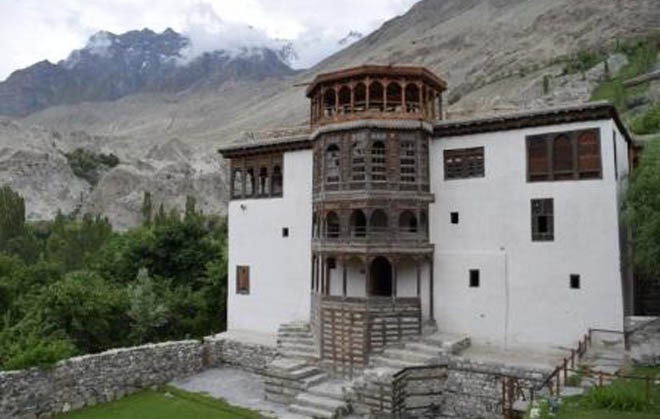
Take off to Khaplu and be delighted by its palace, history and valley views

About three hours’ drive from the small garrison town of Skardu, nestled in the high mountains in northern Pakistan, is the centuries-old kingdom of Khaplu. With Ladakh in Indian Kashmir a stone’s throw away, Khaplu is also known as Little Tibet or The Garden of Eden.
The mountain kingdom of Khaplu, locally known as the Yabgo dynasty, was merged into Pakistan in 1972, along with all other princely states. The signs of rich heritage of a bygone era are spread all over the beautiful ancient town of Skardu, known for its fresh water streams and fruit orchards.
As you drive out of Skardu on your way to Khaplu, the comfortable road passes through sandy deserts, green fields and villages, and the mighty Indus along the road. The riverbed can be more than a kilometre wide, and is a lot peaceful here than downstream, along the narrow Karakorum gorge.
About one hour out of Skardu, you cross a bridge to take the road running parallel to Shyok River. Both rivers, Indus and Shyok, enter Pakistan through India-held Kashmir and Ladakh, and merge into one a few kilometres downstream of Khaplu.
Travelling along the Shyok river, after passing through more hamlets, we finally reached Khaplu. We headed through a maze of narrow streets to arrive at the historic Khaplu Palace, a well-conserved heritage hotel, where the narrow, unassuming alley opens into a vast garden with the magnificent Khaplu Palace in the front.
Khaplu Palace, or Yabgo Khar, has been donated by the family of Raja to the Agha Khan Foundation and is now converted into a heritage site by Serena Hotels. The rooms that were once outhouses have been immaculately restored.
The friendly guide gave us a tour of the palace, explaining that most of the material for the construction, including timber, was shifted from the centuries-old Thoqsi Fort. The palace is converted into a museum with relics like clothing, utensils and weapons. But my favourite was the balcony at the top -- and the extensive valley view it offered. The main courtroom next to the balcony was majestic while the Royal Jharoka, the third floor balcony for Raja to address his populace, was indeed impressive.
Khaplu Palace was constructed by Rajas in 1840, before that, the royal family lived in Thoqsi Fort at the top of a nearby mountain. You can take an hour-long hike through a village and orchards to the ruins of the old fort, where the locals have constructed a mosque. One wonders how many people actually gather here to say prayers five times a day. Despite the hike being tough towards the end, the views from the top are astounding.
The story of Yabgo dynasty is intriguing. The family is able to trace it back to 800AD when one Beg Manthal descended from Yarkand (now in Xinjiang, China) to conquer the Khaplu region. Over time, the kingdom expanded from Ladakh in the east to the present day Ghizer District in the west. When Dogra rulers took over Kashmir from British in 1846, they also extended their rule to Khaplu. The nominal rule of Yabgo dynasty under the Dogra rule continued.
The royal family had palaces at different places, including one at the Tartuk village at the Pakistan-India border, several miles east of Khaplu. One morning in December 1971, the royal family at Tartuk woke up to find that Indian Army had invaded Tartuk, along with border villages of Tyakshi and Thang -- and overnight the local populace had become Indian subjects.
The royal families were separated too. While Raja Nasir Khan and family became the nominal heads of the family in Khaplu, Muhammad Khan Kacho took over as the nominal king of Turtuk in Ladakh.
A visit to the 14th century Chaqchun mosque is a must. The mosque is similar though bigger than the Amburiq mosque of Shigar. It was constructed by Persian and Balti artisans accompanying Syed Ali Hamdani, the Sufi saint accredited with bringing Islam to Kashmir. The woodwork inside the mosque and balconies is exquisite and resembles a Tibetan monastery. Other sources claim the mosque to be originally a Buddhist temple, and conversion happened after the local population embraced Islam.
I was disappointed to see a group of foreigners standing outside and taking photographs, as a board stated that the entry of non-Muslims inside the mosque was restricted. Why? I for one have enjoyed walking through the aisles and listening to hymns in churches all over the world without any danger irrespective of my belief.
Next on my itinerary was the 18th century Astana or the tomb of saint Syed Mir Muhammad. The tomb is a square wooden structure with a conical tower at the top and extensive wood lattice and roof carvings. The crumbling structure was restored by Aga Khan Foundation and won a Unesco award in 2003.
Next to the tomb is the ancient Khanqah Noor Bakshia or mosque cum travel lodge built in 1712. This is one of the largest Khanqahs in Baltistan with extensive work in walnut wood.
Once back at the palace after a full day expedition, you may dine at Serfa Khar or go for a walk along the nearby stream.
Next day you may also make a day trip to the Hoshe valley to trek to Gondogoro-la or Concordia or K2 basecamp, Masherbrum, Gasherbrum I and II and Chogolisa peaks, etc. Another option is exploring the Saling valley across the Shyok River with its trout farms and, more importantly, ancient Buddhist rock carvings. And if you don’t know by now, Khaplu is the last big town on way to Siachen.
Khaplu is an ideal place to unwind in the northern areas. The character of the place will absorb you before you know!